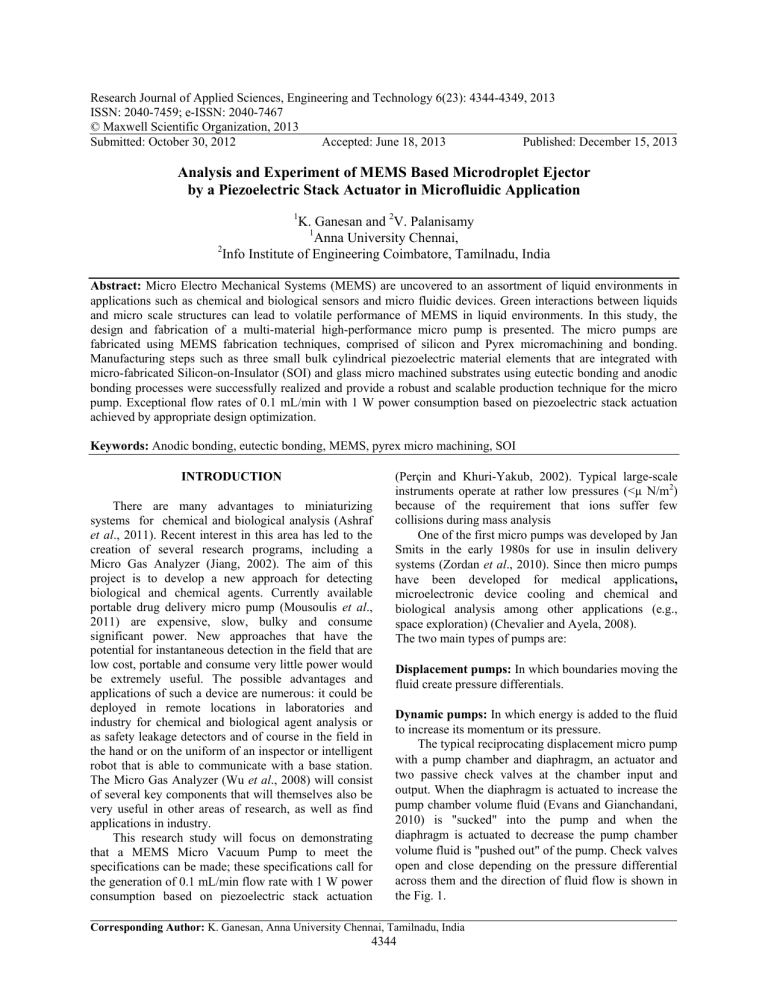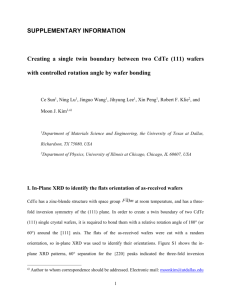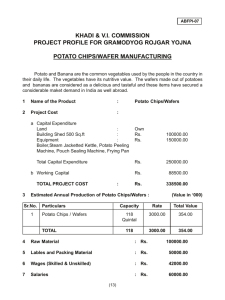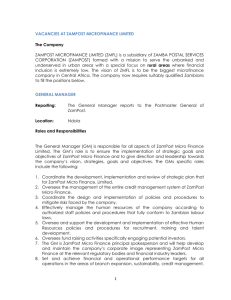Research Journal of Applied Sciences, Engineering and Technology 6(23): 4344-4349,... ISSN: 2040-7459; e-ISSN: 2040-7467

Research Journal of Applied Sciences, Engineering and Technology 6(23): 4344-4349, 2013
ISSN: 2040-7459; e-ISSN: 2040-7467
© Maxwell Scientific Organization, 2013
Submitted: October 30, 2012 Accepted: June 18, 2013 Published: December 15, 2013
Analysis and Experiment of MEMS Based Microdroplet Ejector by a Piezoelectric Stack Actuator in Microfluidic Application
1
K. Ganesan and
2
V. Palanisamy
1
Anna University Chennai,
2
Info Institute of Engineering Coimbatore, Tamilnadu, India
Abstract: Micro Electro Mechanical Systems (MEMS) are uncovered to an assortment of liquid environments in applications such as chemical and biological sensors and micro fluidic devices. Green interactions between liquids and micro scale structures can lead to volatile performance of MEMS in liquid environments. In this study, the design and fabrication of a multi-material high-performance micro pump is presented. The micro pumps are fabricated using MEMS fabrication techniques, comprised of silicon and Pyrex micromachining and bonding.
Manufacturing steps such as three small bulk cylindrical piezoelectric material elements that are integrated with micro-fabricated Silicon-on-Insulator (SOI) and glass micro machined substrates using eutectic bonding and anodic bonding processes were successfully realized and provide a robust and scalable production technique for the micro pump. Exceptional flow rates of 0.1 mL/min with 1 W power consumption based on piezoelectric stack actuation achieved by appropriate design optimization.
Keywords: Anodic bonding, eutectic bonding, MEMS, pyrex micro machining, SOI
INTRODUCTION
There are many advantages to miniaturizing systems for chemical and biological analysis (Ashraf et al ., 2011). Recent interest in this area has led to the creation of several research programs, including a
Micro Gas Analyzer (Jiang, 2002). The aim of this project is to develop a new approach for detecting biological and chemical agents. Currently available portable drug delivery micro pump (Mousoulis et al .,
2011) are expensive, slow, bulky and consume significant power. New approaches that have the potential for instantaneous detection in the field that are low cost, portable and consume very little power would be extremely useful. The possible advantages and applications of such a device are numerous: it could be deployed in remote locations in laboratories and industry for chemical and biological agent analysis or as safety leakage detectors and of course in the field in the hand or on the uniform of an inspector or intelligent robot that is able to communicate with a base station.
The Micro Gas Analyzer (Wu et al ., 2008) will consist of several key components that will themselves also be very useful in other areas of research, as well as find applications in industry.
This research study will focus on demonstrating that a MEMS Micro Vacuum Pump to meet the specifications can be made; these specifications call for the generation of 0.1 mL/min flow rate with 1 W power consumption based on piezoelectric stack actuation
(Perçin and instruments operate at rather low pressures (<µ N/m because of the requirement that ions suffer few collisions during mass analysis
One of the first micro pumps was developed by Jan
Smits in the early 1980s for use in insulin delivery systems (Zordan have been developed for medical applications
Khuri-Yakub, 2002). Typical large-scale et al ., 2010). Since then micro pumps
Displacement pumps:
Dynamic pumps:
,
)
In which boundaries moving the fluid create pressure differentials.
In which energy is added to the fluid to increase its momentum or its pressure.
The typical reciprocating displacement micro pump with a pump chamber and diaphragm, an actuator and two passive check valves at the chamber input and output. When the diaphragm is actuated to increase the pump chamber volume fluid (Evans and Gianchandani,
2010) is "sucked" into the pump and when the diaphragm is actuated to decrease the pump chamber volume fluid is "pushed out" of the pump. Check valves microelectronic device cooling and chemical and biological analysis among other applications (e.g., space exploration) (Chevalier and Ayela, 2008).
The two main types of pumps are:
2 open and close depending on the pressure differential across them and the direction of fluid flow is shown in the Fig. 1.
Corresponding Author: K. Ganesan, Anna University Chennai, Tamilnadu, India
4344
Res. J. App. Sci. Eng. Technol., 6(23): 4344-4349, 2013
(also called check valves) are not actuated by an external control unit; they are opened by pressure differentials and the direction of through-flow and are mostly mechanical flap structures (Jang et al ., 2007) or flexible diaphragms.
Our micro pump design consists of 5 layers (i.e., 5 wafers) but layers 1-3 define the ultimate performance since they contain the channels, chambers, pistons and tethers connecting the pistons to the side walls. The aim of this thesis is to focus on the design and fabrication of
Fig. 1: (a) Piezoelectric actuator in the lateral-strain configuration, (b) piezoelectric actuator in the axial strain configuration
MICRO PUMP DESIGN
To meet our goals for speed, power and vacuum generation the appropriate choice was to use an active valve reciprocating displacement micro pump design
(Santra et al ., 2002). The majority of micro-valves are classified as either active or passive. Passive valves these layers for testing. Layer 4 contains the piezos
(Ashraf et al ., 2010) to drive the pistons and layer 5 provides structural support (Zhang, 2002), both of which can be integrated to make the final device once a suitable design for layers 1-3 is found.
There are three main parts to the test setup: the fluidic connections (Kaneda and Fujii, 2010), electronics and circuitry and computer software. We begin by looking at the fluidic connections. The micro pump dies to be tested are clamped using optical clamps (Jang et al ., 2009) onto the testing platform.
Each pump die has 5 access ports: one input port, one output port (interchangeable) and three actuation ports
(Han et al ., 2006) for the input/output valves and the pump chamber. O-rings (Wester et al ., 2009) help seal the pump die ports against the testing platform.
Fig. 2: (a-m) Different CAD layout of the micro pump layer
4345
Res. J. App. Sci. Eng. Technol., 6(23): 4344-4349, 2013
Fig. 3: DSP layer
The final process flow corresponds to a set of 8 masks and the CAD (Nisar et al ., 2008) layout shown in
Fig. 2.
MEMS micro pumps layer design:
Layer 2-DSP (450 um Si) (Fig. 3):
•
Grow thermal oxide (0.3 um) -preferably buy wafers with thermal oxide pre-grown (Loverich et al ., 2006)
•
HMDS wafers, deposit thin resist on both sides, pre-bake, photo M1 (alignment marks) on topside, develop, post-bake
•
BOE for 4 min, spin-dry wafers
•
Alignment mark etch topside using Al mark recipe on STS 2 or STS 3 for 10 sec
•
Strip resist using piranha, spin-dry wafers
•
HMDS wafers, deposit thin resist on both sides, pre-bake, photo M1 (alignment marks) on bottom side making sure they line up with topside alignment marks, develop, post-bake
•
BOE for 4 min, spin-dry wafers
•
Alignment mark etch bottom side using Al mark recipe on STS 2 or STS 3 for 10 sec
•
HMDS wafers, deposit thin resist on both sides, pre-bake, photo M3 (6 um chamber etch) on bottom side, develop, post bake
•
BOE for 4 min, spin-dry wafers
•
Etch pump chamber from bottom using Jbetch in
STS3 till 6 um chamber depth is obtained (measure using dektak profile meter) (Sbiaa, 2006), rotate wafers at least 4 times during etch
•
Strip resist using piranha, spin-dry wafers
•
Deposit 4 um of thick oxide on both sides using
ICL DCVD
•
HMDS wafers, deposit thick resist on both sides, pre-bake, photo M5 (valve lip and posts) on bottom side, photo M3 (cross channels) on topside, develop, post-bake
•
Etch 4.3 um of oxide on both sides using ICL AME
5000
•
Strip resist using piranha, spin-dry wafers
•
HMDS wafers, deposit thick resist on both sides, pre bake, photo M4 (through holes) on topside, develop, Post bake
4346
•
Etch through holes from the top by (450-30-
Channel width) microns using recipe MIT69A on
STS 2, make sure to rotate wafers often for etch uniformity
•
Strip resist using piranha, spin-dry wafers
•
Ash wafers for 1.5 h
•
HMDS wafers, deposit thick resist on bottom side, post-bake
•
Etch through holes and channels from the top by the Channel width microns making sure to stop short of ~24 um of breaking through the bottom side using recipe MIT69A on STS 2, make sure to rotate wafers often for etch uniformity
•
Strip resist using piranha, spin-dry wafers
•
HMDS wafers, deposit thin resist on topside, postbake
•
Apply blue-tape to topside
•
Etch from the bottom by slightly greater than 24 um to create the valve lips, support posts and open up the valve to pump chamber channels. Use recipe
MIT69A on STS 2, make sure to rotate wafers often for etch uniformity
•
Once complete place wafer in acetone till blue-tape comes off
•
Strip resist using piranha, spin-dry wafers
•
Ash wafers for 1.5 h
Layer 3-SOI (450 um Si) Fig. 4):
•
Grow thermal oxide (0.3 um) -preferably buy wafers with thermal oxide pre-grown
•
HMDS wafers, deposit thin resist on both sides, pre-bake, photo M1 (alignment marks) on topside, develop, post-bake
•
BOE for 4 min, spin-dry wafers
•
Alignment mark etch topside using Al mark recipe on STS 2 or STS 3 for 10 sec
•
Strip resist using piranha, spin-dry wafers
•
HMDS wafers, deposit thin resist on both sides, pre-bake, photo M1 (alignment marks) on Bottom side making sure they line up with topside alignment marks, develop, post-bake
•
BOE for 4 min, spin-dry wafers
Res. J. App. Sci. Eng. Technol., 6(23): 4344-4349, 2013
Fig. 4: (n-t) Different layout of the micro pump SOI Layer
•
Alignment mark etch bottom side using Al mark recipe on STS 2 or STS 3 for 10 sec
•
HMDS wafers, deposit thin resist on both sides, pre-bake, photo M7 (input/output ports) on topside, develop, post bake
•
BOE for 4 min, spin-dry wafers
•
Etch input/output ports from the top by 10 um until the buried oxide layer is reached using recipe
MIT69A in STS 2, rotate wafers at least 4 times during etch
•
Strip resist using piranha, spin-dry wafers
•
Deposit 4 um of thick oxide on the bottom side using ICL DCVD
•
HMDS wafers, deposit thick resist on both sides, pre-bake, photo M6 (tethers) on Bottom side, develop, post-bake
•
Etch 4.3 um of oxide on bottom side using ICL
AME 5000
•
Strip resist using piranha, spin-dry wafers
•
HMDS wafers, deposit thin resist on topside, postbake
•
Apply blue-tape to topside
•
Etch tethers from the bottom till the buried oxide is reached and the right tether width/fillet profile is obtained. Use recipe MIT69A on STS 2. Make sure to rotate wafers often for etch uniformity. Once any tether is complete paint it with resist by hand and let it dry in air for 3 h before proceeding with etching other tethers-don't use oven.
•
Once tethers all completed place wafer in acetone till blue-tape comes off
•
Strip resist using piranha, spin-dry wafers
•
Ash wafers for 1.5 h
4347
Bottom support pyrex layer:
•
Get alignment marks, input/output and actuation ports machined by Bullen Ultra sonics (Kan et al .,
2005) using M8 (pyrex holes)
•
Make a shadow mask for the pyrex wafer: HMDS a blank Si wafer, deposit double layer of thick resist on the topside, pre-bake, photo M9 (shadow mask) on topside, develop, post-bake, mount on quartz wafer and etch through the wafer till the shadow mask is complete using recipe Jbetch on STS 2 or
STS 3
•
Un amount shadow mask from quartz wafer and clean using piranha, then spin-dry wafers
(Maillefer et al ., 2001)
•
Align shadow mask to quartz wafer using bonding aligner and water droplets (to help wafers stick together)
•
Deposit 0.02 um of Titanium adhesive layer followed by 0.2 um of Silver in Ebeam (Selam,
2001)
Bonding and cutting:
•
HF strip all oxide from DSP Layer 2
•
BOE strip all oxide from SOI Layer 3-at the same time the buried oxide will also be removed (don't etch more than buried oxide thickness so make sure that all other oxide on the wafer is already thinner before beginning this step). Can't use HF on this layer
•
Spin dry clean the pyrex bottom layer
•
RCA clean Layer 2, Layer 3 and a blank capping
Si wafer (no HF)
•
Silicon direct bond blank capping wafer to Layer 2 to Layer 3
Res. J. App. Sci. Eng. Technol., 6(23): 4344-4349, 2013
Fig. 5: Layout of the micro pump flow model
Fig. 6: Simulation results of high pressure flow in the micro pump
•
Anneal the 3 layer silicon stack for l h at 950
°
Celcius
•
Anodically bond stack to Pyrex bottom layer
•
Die-saw the micro pump dies using thickest black blade (use die-saw tape on both sides to prevent water/slurry from entering the devices)
RESULTS AND HYPOTHESIS
This round of fabrication led to a fully functioning set of vacuum micro pumps. Using the test setup we performed the main set of tests on these devices:
Test 1: Check for valve and pump chamber leaks by
Actuating the pistons and measuring any flows at the Input or output ports.
Test 2: Check that all pistons can shut down flow by applying an external pressure source at the input and measuring the flow rate at the output as each of the pistons is actuated.
Test 3: Measure the flow rate through the device as a function of the pressure differential applied across it.
Test 4: Measure the micro pump generated flow rate via the 6 stage pumping cycle shown below, as a function of operating frequency
Test 5: Measure the micro pump generated vacuum at a frequency of operation in the micro pump's operating range indicated by Test 4.
PUMP MODELS AND CHARACTERIZATION
To test the pistons we applied a constant pressure source at the input port and measured the output flow
Fig. 7: Simulation results of cumulative flow rate as a function of the frequency rate using a mass flow meter as we attempted to actuate the pistons. We only applied positive pressures to actuate the pistons (no vacuum to pull them down).
Ideally for actuation pressures above the input pressure the pistons should actuate shut and the output flow should drop to.
Air is input at the input port and the output flow rate is measured using a flow sensor. As the three pistons are actuated (indicated by the transparent vertical bars) we expect to see a complete cut off of any flow (green data for the input piston, red for the chamber piston and blue for the output piston). Note that the input and output pistons do work to some degree but that the pump chamber tether is leaking air is shown in the Fig. 5 and 6.
Simulation result: The measured flow rate as a function of the operating frequency (6 stage pumping
4348
Res. J. App. Sci. Eng. Technol., 6(23): 4344-4349, 2013 cycle) is plotted in Fig. 7 which gives the Exceptional flow rates of 0.25 mL/min based on piezoelectric stack actuation.
CONCLUSION
This air micro pumps is the most effective model.
Covent or ware software tool used for the analysis of
Kan, J., M. Xuan, Z. Yang, Y. Wu, B. Wu and
G. Cheng, 2005. Analysis and test of piezoelectric micropump for drug delivery. Sheng Wu Yi Xue
Gong Cheng Xue Za Zhi., 22(4): 809-13.
Kaneda, S. and T. Fujii, 2010. Integrated microfluidic systems. Adv. Biochem. Engin/Biotechnol., 119:
179-194.
Loverich, J.J., I. Kanno and H. Kotera, 2006. Concepts for a new class of all-polymer micropumps. Lab plate/thin film bending/stress and for fluid flow in
MEMS devices. It is a complete pneumatic testing platform and effective testing techniques for the characterization of micro pump devices. This experimental data demonstrating how the various design parameters influence pump and valve performance.
Finally an attractive design that would bring us closer to meet the micro pumps for drug delivery system goals.
Valve leakage data for various valve designs was collected and compared with various models. This micro pump capable of generating vacuum below atmosphere and which was demonstrated at different frequency operation. This pump may be designed pneumaticallydriven with self contained actuation.
Chip., 6(9): n1147-54.
Maillefer, D., S. Gamper, B. Frehner, P. Balmer, H. van
Lintel and P. Renaud, 2001. A high-performance silicon micropump for disposable drug delivery systems. Proceeding of the 14th IEEE International
Conference on Micro Electro Mechanical Systems
(MEMS, 2001), pp: 413-417.
Mousoulis, C., M. Ochoa, D. Papageorgiou and
B. Ziaie, 2011. A skin-contact-actuated micropump for transdermal drug delivery. IEEE T. Biomed.
Eng., 58(5): 1492-8.
10(3): 91-108.
REFERENCES
Ashraf, M.W., S. Tayyaba and N. Afzulpurkar, 2011.
Micro Electromechanical Systems (MEMS) based microfluidic devices for biomedical applications.
Int. J. Mol. Sci., 12(6): 3648-3704.
Ashraf, M.W., S. Tayyaba, A. Nisar, N. Afzulpurkar,
D.W. Bodhale, T. Lomas, A. Poyai and
A. Tuantranont, 2010. Design, fabrication and analysis of silicon hollow microneedles for transdermal drug delivery system for treatment of hemodynamic dysfunctions. Cardiovasc. Eng.,
Chevalier, J. and F. Ayela, 2008. Microfluidic on chip viscometers. Rev. Sci. Instrum., 79: 76-102.
Evans, A.T. and Y.B. Gianchandani, 2010. A low leakage liquid seal for micromachined gas valves.
Rev. Sci. Instrum., 81(6): 66-105.
Han, A., N.F. de Rooij and U. Staufer, 2006. Design and fabrication of nanofluidic devices by surface micromachining. Nanotechnology, 17(10):
2498-503.
Jang, L.S., K. Shu, Y.C. Yu, Y.J. Li and C.H. Chen,
2009. Effect of actuation sequence on flow rates of peristaltic micropumps with PZT actuator. Biomed.
Microdevices, 11(1): 173-81.
Jang, L.S., Y.J. Li, S.J. Lin, Y.C. Hsu, W.S. Yao,
Nisar, A., N. Afzulpurkar, A. Tuantranont and
B. Mahaisavariya, 2008. Three dimensional transient multifield analysis of a piezoelectric micropump for drug delivery system for treatment of hemodynamic dysfunctions. Cardiovasc. Eng.,
8(4): 203-218.
Perçin, G. and B.T. Khuri-Yakub, 2002.
Piezoelectrically actuated flextensional micromachined ultrasound droplet ejectors. IEEE
T. Ultrason. Ferr., 49(6): 756-66.
Santra, S., P. Holloway and C.D. Batich, 2002.
Fabrication and testing of a magnetically actuated micropump. Sensors Actuat., B873: 58-64.
Sbiaa, Z., 2006. MEMS fabricated chip for an implantable drug delivery device. Conf. Proc. IEEE
Eng. Med. Biol. Soc., 1: 5621-4.
Selam, J.L., 2001. External and implantable insulin pumps: current place in the treatment of diabetes.
Exp. Clin. Endocrinol. Diabete, 109S3: 33-40.
Wester, B.A., J.D. Ross, S. Rajaraman and M.G. Allen,
2009. Packaging and characterization of mechanically actuated microtweezers for biomedical applications. Conf. Proc. IEEE Eng.
Med. Biol. Soc., 2009: 2744-7.
Wu, M.H., S.B. Huang, Z. Cui and G.B. Lee, 2008. A high throughput perfusion-based microbioreactor platform integrated with pneumatic micropumps for three-dimensional cell culture. Biomed.
Microdevices, 10(2): 309-319.
Zhang, L., 2002. Measurements and modeling of twophase flow in microchannels with nearly
M.C. Tsai and C.C. Hou, 2007. A stand-alone peristaltic micropump based on piezoelectric actuation. Biomed. Microdevices, 9(2): 185-94.
Jiang, L., 2002. Closed-loop electro osmotic micro channel cooling system for VLSI circuits. IEEE T.
Compon. Pack. T., 253: 47-55. constant heat flux boundary conditions.
J. Microelectromech. Syst., 11: 12-19.
Zordan, E., F. Amirouche and Y. Zhou, 2010. Principle design and actuation of a dual chamber electromagnetic micropump with coaxial cantilever valves. Biomed. Microdevices, 12(1): 55-62.
4349




